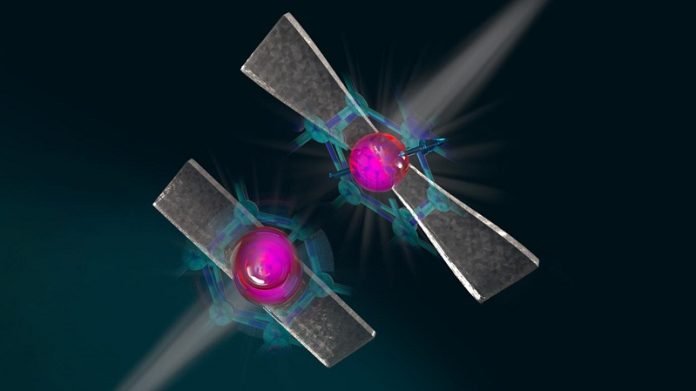
Researchers are making a quantum leap in the development of quantum networks.
Their latest breakthrough, published in Physical Review X, involves using stretched diamond films to create more manageable and cost-effective quantum bits (qubits).
Qubits are the fundamental building blocks of quantum computing and networks.
Unlike traditional bits used in computers today, qubits have unique properties that can make networks almost immune to hacking.
But there’s a catch: qubits are incredibly sensitive to heat and vibrations, requiring ultra-cold temperatures to function correctly.
This sensitivity has been a significant hurdle in advancing quantum networks, as it demands extensive, expensive infrastructure to keep these systems cool.
Alex High, an assistant professor at the Pritzker School of Molecular Engineering and leader of the study, and his team set out to solve this problem.
They collaborated with researchers from Argonne National Laboratory and Cambridge University to find a way to make qubits more practical.
Diamonds, known for their hardness and beauty, also hold promise for quantum technology. The team focused on a type of qubit made from diamonds, known as Group IV color centers.
These diamond-based qubits are great at maintaining quantum entanglement (a critical property for quantum computing) but typically need to be just a hair above absolute zero to work.
The researchers experimented with the diamond’s structure, trying to make it more adaptable. They found that by laying a thin film of diamond over hot glass, they could ‘stretch’ the diamond at a molecular level.
As the glass cools, it contracts more slowly than the diamond, gently pulling apart the diamond’s atomic structure. This process is similar to how pavement expands or contracts with the temperature changes of the earth beneath it.
This tiny stretching of the diamond had a massive impact.
First, it allowed the qubits to maintain their coherence at temperatures up to 4 Kelvin (about -452°F), which is still very cold but much more achievable with less specialized equipment. This change means a significant reduction in infrastructure and operating costs.
Secondly, and perhaps more importantly, this adjustment enabled the qubits to be controlled with microwaves instead of light in the optical wavelength.
Earlier methods introduced noise and reduced reliability, but using microwaves improved the fidelity of the qubits to 99%.
Xinghan Guo, a Ph.D. student in physics in High’s lab and first author of the paper, noted that it’s rare to see improvements in both temperature tolerance and control simultaneously. This development marks a significant step forward in the practical application of quantum networks.
Benjamin Pingault from Argonne National Laboratory and Mete Atature from Cambridge University, both co-authors of the study, highlighted the importance of this innovation for Group IV color centers in diamond.
They believe this breakthrough paves the way for developing diamond-based devices for quantum networks.
This research utilized the facilities at the Pritzker Nanofabrication Facility and Materials Research Science and Engineering Center at UChicago.
The team, including scientists from multiple institutions, shows the collaborative effort necessary to push the boundaries of quantum technology, bringing us closer to more efficient and secure quantum networks.



